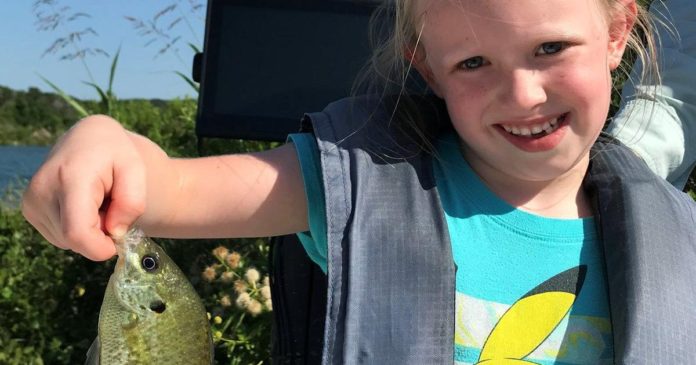As the water temperature on our local reservoirs has steadily increased since late March to just over 70F now, sunfish have begun to show up in force in shallow water where they are easily accessed by both boat anglers and bank anglers.
These fish are now both feeding and establishing their turf, but will soon focus on spawning. All of these activities will take place in shallow water.
With the weather forecast predicting highs in the 90s for the entire week to come, there will be no turning back for these sunfish. They will most likely remain in the shallows from now until the water cools significantly in the fall, typically in late September or early October.
Sunfish tend to be easy to catch, and are therefore a great target species for adults looking to introduce kids to the sport. What sunfish lack in size, they make up for in both numbers and in their eagerness to take properly presented baits and small lures.
Sunfish are a cover-loving species of fish, so to find them, you must find the cover they live in. On Stillhouse Hollow Lake, the acres of abundant, green hydrilla now growing there have allowed the sunfish (and largemouth bass) populations to thrive, but the fish are now also more spread out than before the hydrilla became so widespread.
Still, the backs of coves, where rock and wood cover intersperse with hydrilla, is a solid bet for locating sunfish. Also, the inside edge of hydrilla where it begins to grow, just feet or yards from the shoreline, is a good bet on that body of water.
On Belton Lake, the backs of coves are also productive, as that is where driftwood, leaves and debris collect and sink, thus offering at least some cover in a lake which is largely devoid of such shallow water cover.
A few tools will be helpful in targeting sunfish. High on that list is a pair of polarized sunglasses. These need not be prescription glasses, nor expensive. For those who wear prescription lenses, a pair of slip-over polarized glasses which rest over the prescription glasses may be a good solution.
Regardless, polarized lenses help cut the glare of the sun off the water’s surface and make it possible to peer more deeply into the water in order to spot both sunfish and the underwater cover they hide in and around.
Keeping presentations small and simple tends to yield the best results for sunfish. I equip the children I take aboard my boat with 9- to 11-foot long telescoping bream poles, which are like the modern-day version of the old cane pole.
Made of multiple telescoping fiberglass segments, these poles, like the Shakespeare Wonderpole, the B’n’M Black Jewel Original BreamBuster, or Lew’s Bream Stick, eliminate the need for a reel.
The fishing line (6- or 8-pound test is a good size to start with) is tied to the thin end of the pole and trimmed to the same length as the pole.
To this simple pole setup, I use a small balsawood float which is about 2-3 inches long and only 3/8-inch in diameter, a small split-shot (heavy enough to make the float stand vertically, but not cause it to sink), and a #14 or #16 hook.
These small hooks are so small, they are typically not found in the average sporting goods section of a department store or mass merchandising store. I suggest looking in the fly fishing or fly-tying department at Bass Pro Shops or Cabela’s, or ordering online from one of the many flyshops found there.
Long-shanked hooks are helpful to both fish and fisherman, as they are more easily removed when (not if) a sunfish inhales a bait and gets deeply hooked. To be prepared for this eventuality, a pair of six-inch, curved-tip forceps is a must, as is a tool called the Ketchum Release Tool (in the smallest size offered).
Baits must also be small. Remember, sunfish typically dine on organisms barely able to be seen with the naked eye. I like to buy redworms, and then cut those worms into six or seven segments, slipping just one segment onto the hook at a time as my bait.
I like to route the hook through the core of that worm segment, and not hook it through from side to side, thus avoiding forming loops in the bait which aid the sunfish in grabbing ahold of the bait and tearing it off the hook without getting caught.
Whether you are fishing for sunfish to introduce a child to the sport or just out to catch your own sunfish, perhaps as bait for larger fish, the time has come to find these sporty, abundant fish up in the shallows.
Credit: Source link






























